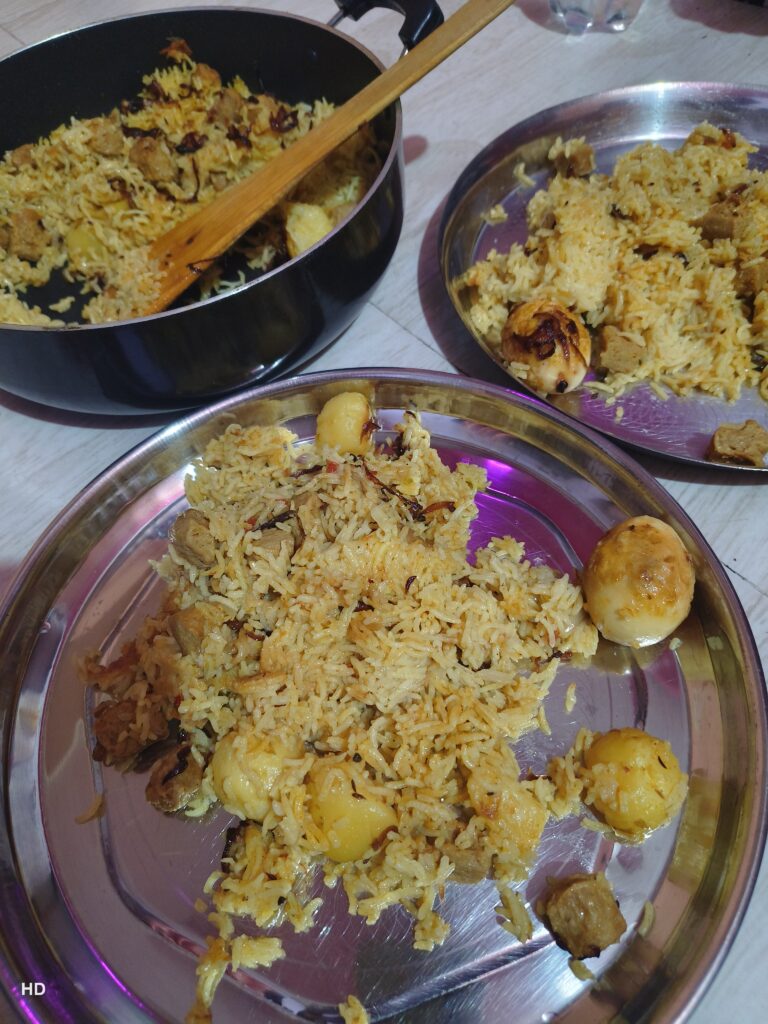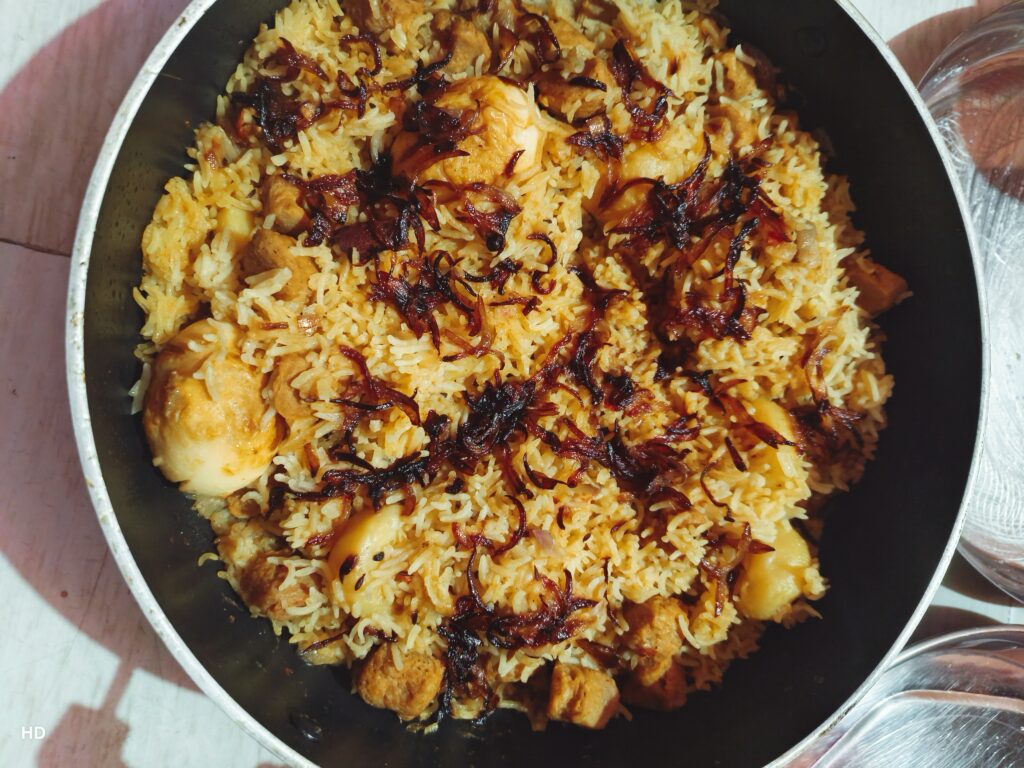Homemade Special Traditional Egg Biryani – A Complete Guide to Flavor and Tradition
Biryani is more than just food—it is an emotion, a celebration of spices, and one of the finest culinary treasures of the Indian subcontinent. While chicken, mutton, and fish biryanis get plenty of attention, one variety that often steals the show with its simplicity and unique taste is the Egg Biryani.
Egg biryani is truly special. It combines the richness of aromatic rice, the boldness of spices, and the wholesome comfort of eggs into one delightful dish. Unlike meat biryanis, which can feel heavy or time-consuming, egg biryani is easier to prepare while still offering the same layers of fragrance, taste, and satisfaction.
In this guide, we’ll dive deep into everything about homemade egg biryani: its cultural significance, ingredients, step-by-step recipe, cooking methods, variations, and serving suggestions. By the end, you’ll be fully ready to prepare your very own special egg biryani at home.
1. The Significance of Egg Biryani
Eggs are often called the “poor man’s protein,” but in reality, they’re a versatile ingredient that transcends all social classes. Egg biryani is loved by college students, working professionals, and families alike.
For those who don’t eat meat or prefer a lighter alternative, egg biryani becomes a star dish. It’s also budget-friendly, quick to prepare, and equally grand in presentation. Whether for a Sunday family lunch, a festive gathering, or a cozy dinner, egg biryani is always welcome at the table.

2. Ingredients for Homemade Egg Biryani
Egg biryani has three main components: the rice, the masala, and the eggs. Let’s list the ingredients in detail.
For the Rice:
- Basmati rice – 2 cups (long-grain, aromatic)
- Water – 6 cups (for boiling)
- Bay leaf – 1
- Green cardamoms – 3–4
- Cloves – 3–4
- Cinnamon stick – 1-inch piece
- Star anise – 1
- Salt – 1 teaspoon
For the Eggs:
- Eggs – 6, boiled and peeled
- Turmeric powder – ½ teaspoon
- Red chili powder – ½ teaspoon
- Oil – 1 tablespoon (for shallow frying)
For the Biryani Masala:
- Onions – 3 large, thinly sliced
- Tomatoes – 2 medium, chopped
- Green chilies – 2–3 slit
- Ginger-garlic paste – 2 tablespoons
- Yogurt – ½ cup
- Fresh coriander leaves – handful, chopped
- Fresh mint leaves – handful, chopped
- Red chili powder – 1 teaspoon
- Coriander powder – 1 teaspoon
- Turmeric powder – ½ teaspoon
- Garam masala powder – 1 teaspoon
- Biryani masala powder – 1 tablespoon (optional, for extra flavor)
- Oil – 4 tablespoons
- Ghee – 2 tablespoons
- Salt – as required
For Garnish & Layering:
- Fried onions (birista) – ½ cup
- Warm milk – ¼ cup
- Saffron strands – 8–10 (soaked in milk)
- Extra mint and coriander leaves
3. Step-by-Step Recipe for Special Egg Biryani
Step 1: Preparing the Rice
- Wash and soak basmati rice for 30 minutes. This ensures long, separate grains.
- Boil 6 cups of water in a large pot. Add whole spices (bay leaf, cardamom, cloves, cinnamon, star anise) and salt.
- Add the soaked rice and cook until it is 70% cooked (grains should still be slightly firm).
- Drain and set aside.
💡 Tip: Do not overcook rice, as it will steam again during dum (final cooking).
Step 2: Preparing the Eggs
- Boil eggs, peel them, and make small slits with a knife (to absorb masala).
- Sprinkle turmeric and red chili powder.
- Heat a tablespoon of oil in a pan and shallow fry the eggs until slightly golden. Set aside.
💡 Tip: Light frying adds a smoky flavor and prevents eggs from breaking inside the biryani.
Step 3: Preparing the Masala
- Heat oil and ghee in a heavy-bottomed pan.
- Add sliced onions and fry until golden brown. Keep aside a small portion for garnishing.
- To the remaining onions in the pan, add ginger-garlic paste and sauté until fragrant.
- Add chopped tomatoes and cook until soft and oil begins to separate.
- Mix in red chili powder, coriander powder, turmeric, garam masala, and biryani masala.
- Add yogurt, mint, and coriander leaves. Cook until the masala becomes rich and thick.
- Add the fried eggs and coat them well with the masala.
Step 4: Layering the Biryani
- In a large heavy-bottomed pot or handi, spread one layer of cooked rice.
- Add a layer of egg masala with some gravy.
- Sprinkle fried onions, mint, and coriander.
- Repeat layers until rice and masala are used up. Finish with rice on top.
- Drizzle saffron-infused milk and a teaspoon of ghee.
- Cover tightly with a lid (or seal with dough for traditional dum cooking).
Step 5: Dum Cooking (Final Step)
- Place the pot on low heat. For safety, keep a tava (flat pan) under the pot to avoid direct flame.
- Cook on dum for 20–25 minutes.
- Allow it to rest for 10 minutes before serving.
When you open the lid, the aroma of saffron, ghee, and spices will instantly transport you to food heaven.
4. Tips for Perfect Egg Biryani
- Use aged basmati rice for long, fluffy grains.
- Do not overcook rice—it must be slightly underdone before layering.
- Use both mint and coriander leaves for authentic biryani flavor.
- Fry onions slowly until golden for natural sweetness.
- Always cook biryani on low heat during dum to let flavors infuse properly.
5. Regional Variations of Egg Biryani
Biryani is diverse across India, and egg biryani also has many versions:
- Hyderabadi Egg Biryani: Rich with saffron, fried onions, and strong spices, cooked using the dum method.
- Kolkata Egg Biryani: Lighter in spices, often includes boiled potatoes along with eggs.
- South Indian Egg Biryani: Uses curry leaves, coconut milk, and spicy masalas for a fiery taste.
- Mughlai Egg Biryani: Creamier, with yogurt, ghee, and aromatic whole spices dominating the flavor.
6. What to Serve with Egg Biryani
Egg biryani pairs wonderfully with:
- Raita (yogurt with cucumber, onion, or boondi)
- Salad (onion rings, cucumber slices, lemon wedges)
- Papad or roasted crisps
- A light dessert like kheer or gulab jamun
7. Nutritional Value of Egg Biryani
Egg biryani is not just delicious but also wholesome:
- Eggs provide high-quality protein, vitamins, and minerals.
- Rice gives carbohydrates for energy.
- Spices like turmeric, cumin, and ginger aid digestion and boost immunity.
- Yogurt and ghee add probiotics and healthy fats.
While it is calorie-rich, it’s also a balanced meal when enjoyed in moderation.
8. Why Egg Biryani is Special
- It is budget-friendly compared to meat biryani.
- It is quicker to prepare but still festive in flavor.
- It suits both vegetarians who eat eggs (eggetarians) and non-vegetarians.
- It is universally loved—from children to elders.
Egg biryani is one of those dishes that prove you don’t need complicated ingredients to create a masterpiece—just good quality rice, eggs, spices, and love.
9. Common Mistakes to Avoid
- Adding too much water while cooking rice—leads to mushy biryani.
- Not sealing the pot properly during dum—the aroma escapes.
- Overcooking eggs until rubbery.
- Using too many spices without balance.
- Rushing the resting stage after dum—flavors need time to settle.
Also Read: Purely Homemade Crispy Chicken Pakoda
10. Final Thoughts
Egg biryani is a dish that combines simplicity with grandeur. The layers of spiced rice, golden eggs, and fragrant masala create a symphony of flavors that delight the senses. It is perfect for everyday meals and equally fitting for festive occasions.
Making egg biryani at home allows you to control the ingredients, adjust spices to your preference, and serve a dish that brings your family together. Every spoonful carries not just the taste of spices but the warmth of tradition and love.
So next time you want to prepare something special without spending hours in the kitchen, make a pot of homemade special egg biryani. With this recipe, you can enjoy a royal meal right at your dining table.
For more updates – Please follow this blog!



Pingback: How to Make Fried Rice and Chili Chicken at Home - HotLiveNews9